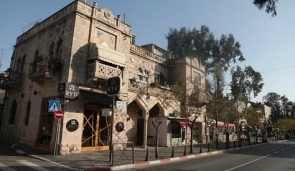Israeli researchers: Jerusalem's trendiest street built over biblical site of the 'Kings' Garden'
 Sunday, October 23, 2011 at 03:54PM
Sunday, October 23, 2011 at 03:54PM Two researchers see in the special topography of Jerusalem evidence that would require that we redraw our understanding of the geography of the city in ancient times.
By Nir Hasson
Haaretz 23 October 2011
There's an old cliche in Jerusalem that the city's most Tel Aviv-like street is Emek Refaim in the German Colony, with its wealth of cafes and boutiques. The reason, according to the cliche, is that the street is almost completely flat, like Tel Aviv streets.
True, the city's other main streets require some exertion on the uphill portions, but there are actually two researchers who see in the special topography evidence that would require that we redraw our understanding of the geography of Jerusalem in ancient times.
 Jerusalem's Emek Refaim street April 10 2011 Photo by: Daniel Bar-On
Jerusalem's Emek Refaim street April 10 2011 Photo by: Daniel Bar-On
Writing in the publication "Beit Hamikra" ("House of the Bible" ), two Tel Aviv University professors, Oded Lipschits and Nadav Na'aman, propose a view of ancient Jerusalem that is a substantial departure from the accepted wisdom up to now about the city.
Major change
The most major change in conception relates to the area called "Gan Hamelech" ("The King's Garden" ) south of the current Old City walls in the lower portion of the Silwan neighborhood. The area has been in the news over the past couple of years since Jerusalem Mayor Nir Barkat announced plans to create an archaeological park there, at a site which is considered among the most ancient biblical areas of the city. Tradition has it that Gan Hamelech was the site at which King Solomon wrote the Book of Ecclesiastes ("Kohelet" ). The garden's beauty is also noted in the biblical Song of Songs.
 |
Prof. Oded Lipschits |
| Photo by: Moti Milrod |
The accepted site of the garden is the intersection of the Kidron and Hinnom valleys, which is today the lower section of the Silwan neighborhood. Over the past 20 years, an Arab neighborhood known as Al-Bustan has developed there, consisting of about 90 homes, all of which were constructed without building permits.
Mayor Barkat's plan for the archaeological park calls for the demolition of 22 of the homes, but the two Tel Aviv University academics now argue that the ancient Gan Hamelech was not located in present-day Silwan but rather at one end of Emek Refaim Street. Lipschits' and Na'aman's hypothesis is based on archaeological digs that Lipschits led in collaboration with Germany's Heidelberg University at Kibbutz Ramat Rachel, which overlooks Emek Refaim from the east. The kibbutz adjoins Jerusalem's municipal boundaries.
The Ramat Rachel excavations revealed an important ancient government center there dating from the 8th century B.C.E., the period of the independent Judean kingdom. Lipschits says agricultural produce was apparently collected there as a source of government tax revenue.
The two Tel Aviv University researchers also point to work done in the 1950s by archaeologist Yohanan Aharoni, who identified Ramat Rachel as the site of the ancient "Beit Hakerem," which is not to be confused with the current Jerusalem neighborhood of the same name. There are repeated references in ancient sources to Beit Hakerem as a high spot between Jerusalem and Tekoa.
Based on the identification of Ramat Rachel as Beit Hakerem and bearing in mind the unique, flat topography of Emek Refaim, the two academics suggest that Emek Refaim, which means "Ghost Valley," is really the valley of the king in which Gan Hamelech, the King's Garden, was located in biblical times. The first reference to the valley of the king is in the 14th chapter of the Book of Genesis, where it is said the king of Sodom set out from there, referring to it also as the Valley of Shaveh, to meet Abraham.
The Tel Aviv University researches contend that the word "shaveh" means plain. That would imply level ground, making Emek Refaim, they say, the logical site of the valley of the king. They also say that before Ramat Rachel was known as Beit Hakerem, it appears to be the site of Baal-Perazim mentioned in Chapter 5 of the second book of Samuel.
The numerous archaeological finds relating to agricultural in what is now the German Colony reinforce the contention that the ancient Judean kingdom established farms there. That would put Gan Hamelech, the King's Garden, somewhere between what is today Jerusalem's Liberty Bell Park and the city's old railway station and several hundred meters away from the more widely accepted site in Silwan.
 APJP |
APJP |  Post a Comment |
Post a Comment |
Reader Comments